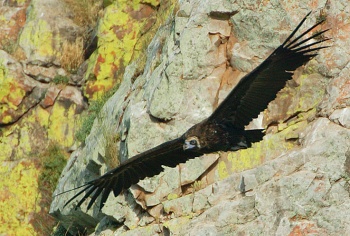m |
|||
| Line 11: | Line 11: | ||
HABITAT Found in hilly and mountainous country, sometimes lowlands, in wooded or open areas. Nest is usually built in a tree, sometimes on a rock ledge. Searches for carrion over open areas with domestic stock or wild ungulates. | HABITAT Found in hilly and mountainous country, sometimes lowlands, in wooded or open areas. Nest is usually built in a tree, sometimes on a rock ledge. Searches for carrion over open areas with domestic stock or wild ungulates. | ||
==External Links== | ==External Links== | ||
| − | *[http://www. | + | {{GSearch|Aegypius+monachus }} |
| + | *[http://www.orientalbirdimages.org/birdimages.php?action=birdspecies&Bird_ID=835&Bird_Image_ID=1143&Bird_Family_ID=96 View more images of this species on Orientalbirdimages] | ||
[[Category:Birds]] | [[Category:Birds]] | ||
Revision as of 09:26, 1 September 2007
| This article is a stub. This article is short and lacking information. You can help the BirdForum Opus by expanding it. |
- Aegypius monachus
Identification
Eurasian Black Vulture (Cinereous or Monk Vulture) Aegypius monachus RANGE Eurasia. Rare and declining in the Western Palearctic, in the west now breeding only in central Spain and Mallorca and in the east in northern Greece, Turkey and Armenia, the Crimea and the Caucasus. In 1996 began breeding in very small numbers in eastern Portugal after an absence of several decades and in the same year the first breeding in France for a century took place in the Massif Central as a result of a reintroduction programme. Occurs with some regularity in the Rhodope Mts of Bulgaria but breeding is rare. More numerous and widespread further east ranging from northern Iran east to northern and western China.
Most are resident as adults, but young birds disperse, often to areas outside breeding range. Guadalquivir marismas are a regular haunt of immatures in Spain, especially in winter and there are often small numbers present in south Portugal. Mallorcan birds are rarely seen outside breeding range in the mountains of the north. Very small numbers recorded annually crossing the Bosphorus, and recorded south to Sinai and Egypt. In the past also recorded in many European countries north to the Netherlands, Denmark and Estonia but today most records from northern Europe are thought more likely to be escapes. One recorded in Wales in the winter of 1977-78 is not accepted as a wild bird. However, birds thought to be genuine vagrants recorded in Tunisia in March 1991 and southern France in April 1991. More recently a juvenile in the Netherlands in July-August 2000 is accepted as a wild bird. Vagrants also recorded in Switzerland, Cyprus and the Straits of Messina, Sicily. In the east a rare visitor to Burma and northern Indochina and a vagrant to Hong Kong and Japan.
HABITAT Found in hilly and mountainous country, sometimes lowlands, in wooded or open areas. Nest is usually built in a tree, sometimes on a rock ledge. Searches for carrion over open areas with domestic stock or wild ungulates.




